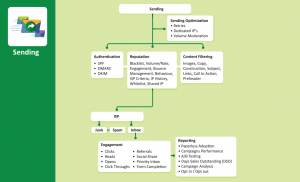How to Avoid Serious Cybersecurity Threats to Your Business This Year
When creating your business outlook for this year, you’ve probably come up with things to accomplish and avoid. A cybersecurity attack undoubtedly falls into the second category. Here are some actionable strategies to steer clear of cyberthreats this year.
Educate Your Team About Phishing Attempts
Phishing attacks occur when cybercriminals pose as legitimate people or companies and try to convince victims to disclose their passwords or other sensitive details. Such perpetrators often use realistic graphics and elaborate methods to make people fall for the trick. These emails often come disguised as messages related to invoices, payroll, taxes or other matters likely to prompt employees to take quick action.
It’s crucial to tell your workers about the warning signs associated with phishing emails — such as grammar and spelling errors or links that redirect to strange URLs. Once a cybercriminal gets details through a phishing email, it’s much easier for them to access your online infrastructure and wreak havoc.
Many companies run real-world tests to see how employees would respond to phishing emails. This approach can help you determine if gaps exist in worker education. However, you should conduct them with care and avoid methods that could create an unintended backlash or drop in morale.
GoDaddy made headlines recently when it created a phishing email informing people about an upcoming holiday party and year-end bonus. The company asked people to provide details to claim the money. However, instead of receiving checks, the people who submitted the forms got word that they had to complete more training due to failing the phishing test. Since 2020 was such a tough year, people understandably were not happy that their company misled them about the extra cash.
Encourage Excellent Password Hygiene
Poor password practices can collectively have the same effects as a phishing email. They make it easier for hackers to breach systems. Many people use easy-to-guess passwords, such as “password” or “123456.” Others reuse the same ones on several sites. Doing that gives unauthorized users greater access after cracking the login details for a single portal.
Provide your workers with real-life examples of how they could unintentionally compromise the security a password should provide. For example, someone might ask their colleague to share their password because they are trying to get something done before the company’s help desk staff arrives. People naturally want to help others and may not immediately see the issue with letting someone use their passwords.
Try to strike a balance between tight cybersecurity and user-friendly convenience. Most people have dozens of passwords to remember for work and personal reasons. It’s no surprise that they often pick easy ones. They don’t want to forget them and disrupt their workflows.
One option is to provide people with a password manager tool. It stores login details so they don’t need to remember them. Some products also generate passwords that follow best practices. Another option is to do away with passwords by using other methods of identity verification. Consider staying abreast of the possibilities, so you’ll know if better solutions exist.
Familiarize Yourself With Compliance Requirements
Companies can make significant progress in cybersecurity by ensuring they comply with all relevant requirements. For example, contractors and subcontractors working for the United States’ Department of Defense must comply with the Cybersecurity Maturity Model Certification (CMMC) before submitting bids for projects. It’s a five-level framework representing a company’s preparedness against online threats.
State cybersecurity requirements may apply to your organization, too. California’s not-yet-enacted Privacy Rights Act mandates that companies undergo annual cybersecurity audits. It also requires taking precautions by using contractual clauses related to the transfer of customer data to third parties.
Research whether applicable regulations stipulate how to notify authorities of breaches. The General Data Protection Act (GDPR) — which applies to companies with customers in the European Union — includes a 72-hour window for companies to report details to relevant authorities.
Staying in compliance may seem overwhelming at first. However, the rules you must follow could go a long way in keeping your data safe or making any breaches less severe. Plus, sticking to the regulations helps you avoid financial penalties. If you work with vendors, assess whether they operate in compliance, too. You wouldn’t want to get negative media attention due to a provider failing to abide by cybersecurity regulations.
Create Backup Copies of Your Data
Backing up your business-critical data could help you keep operating smoothly if a ransomware attack occurs. This allows cybercriminals to deny access to files until victims pay a specified amount to restore them. However, even paying doesn’t guarantee restoration of the stolen material.
Online perpetrators love to cause massive problems with this kind of attack. Affected parties often must resort to using pen-and-paper methods to accomplish their formerly digital-based tasks. Ransomware attacks at hospitals frequently require sending incoming patients elsewhere or rescheduling nonurgent treatments.
Deciding to make copies of your data does not address the whole problem. After all, you’ll need to dig deeper to find out how the perpetrator distributed the message and which specific vulnerabilities allowed them to seize your company’s files.
However, having copies of the material means the hackers won’t cause parts of your company to virtually shut down due to lack of data access. Take the time to explore the various backup methods, ranging from external hard drives to cloud storage. Consider how easily you could recover the content from a backup, too.
Schedule a Cybersecurity Audit
Having a cybersecurity audit performed is an excellent way to know where your company stands in keeping its data safe. An audit’s results can also be immensely informative for showing you where the risks exist.
If you don’t know where the weak points are, it’s much more difficult — and often impossible — to ensure you have your bases covered. Beyond the issue of inadequate visibility, many companies fall short by failing to monitor for known risks. A cybersecurity auditor can suggest the most effective ways for your company to do that based on your budget and human resources.
Most cybersecurity audits also entail examining your incident response plan. Have you ever tested it for real-life feasibility? If not, it may turn out significant gaps or steps look good on paper but are challenging to abide by during an urgent situation.
The outcomes of a cybersecurity audit may bring both good and bad surprises. However, try not to feel too discouraged about the areas needing improvement. Knowing about the issues is the first step to take in addressing them.
Offer Transparency if a Breach Happens
Cyberattacks can still happen to businesses that do everything right. Acting decisively when those events occur is crucial for mitigating the damage. Knowing what to do and when requires following your incident response plan.
Moreover, if an event causes a data breach that compromises customer information, be upfront with the affected parties. Communicate with them while the remediation is underway, providing honest information. It’s OK if you can’t address everything customers would want to know right away. Let them know that the investigation is still happening, and you’ll update them as more information becomes available.
It may also be best to create a landing page that gives customers the latest details. Besides conveying them on the website, your company could also set up a dedicated phone number to handle queries from affected people.
In addition to telling clients what happened, spell out what your company is doing to prevent future problems. Doing that will help people feel confident they can keep trusting your company despite what happened. Moreover, being honest with customers right away will stop the breach from getting out of hand due to incorrect assumptions or a loss of trust.
Take Action Today to Prevent Future Problems
There are no guaranteed ways to prevent cyberthreats. However, the tips listed here can make them significantly less likely to happen. Treat your efforts toward improved cybersecurity readiness as a journey. It’s OK to take small, frequent steps in the right direction. Doing that will put you on the right track to become more resilient against online dangers.
About the Author: Eleanor Hecks

Eleanor Hecks is editor-in-chief at Designerly Magazine. Eleanor was the creative director and occasional blog writer at a prominent digital marketing agency before becoming her own boss in 2018. She lives in Philadelphia with her husband and dog, Bear.
(776)
Report Post








